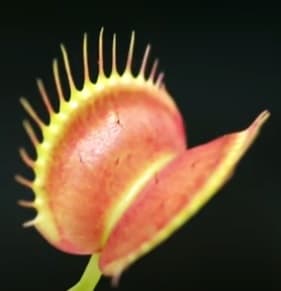As an Amazon Associate, this site earns commissions from qualifying purchases. For more details, click here.
Venus flytraps are naturally found in North and South Carolina, but now they are all over the United States owing to their popularity. These plants have an undeserved reputation as being hard to grow, so in this guide I’ll explain their life and seasonal cycle.
Venus flytraps emerge from dormancy in mid February or March, and grows throughout spring and summer. When fall arrives, the plant prepares for dormancy and repeats the cycle.
If you want to grow Venus flytraps, understanding their life cycle is a must. Sometimes new growers end up throwing the plant away during dormancy, believing it died. So without further ado, let’s dive in.
Venus Flytrap Seasonal Cycle
The seasonal cycle of Venus flytraps is similar to other plants. It is vital for the plant to go through each aspect to survive.
Spring and summer. After going through dormancy in winter, Venus flytraps start to grow again in spring. Some of them emerge from dormancy as early as mid-February if the weather has warmed enough.
If February is too cold, the plant waits until March to reemerge. The plant starts regrowing and blooming in spring and throughout summer.
Venus flytraps 3-4 years old start to flower in spring, which contain seeds. It’s also during this time the plant starts to make traps again. Check out my guide if your Venus flytrap has no traps.
Fall and winter. As summer draws to a close, Venus flytraps start preparing for winter. The plant begins to shed leaves in the fall, along with its traps.
When winter arrives, Venus flytraps go back into dormancy. The plant shrinks, remaining leaves may turn black, and its traps won’t eat anymore.
Venus flytraps must remain dormant for 8-10 weeks. As winter draws to a close, the plant will slowly come back and the cycle will repeat itself.
Venus Flytrap Life Cycle
Healthy Venus flytraps can live up to 20 years. its life cycle can be divided into four parts:
- Year 1: seedling and initial growth
- Year 2: traps continue to grow
- Year 3: blooming
- Year 4 onwards: maturity
Year 1: seedlings and first dormancy
The life cycle of a Venus flytrap begins with the seeds that its flowers produce. You can also grow these plants through leaf cutting, which I will get to a bit later.
The best time to germinate Venus flytrap seeds is August through September. The younger and riper the seedlings, the greater the chance of success.
To germinate Venus flytrap seeds:
- Put soil in a pot. I recommend Soil Sunrise as it is made specifically for Venus flytraps. Do not use regular soil and do not add fertilizers.
- Water the soil until it is moist. Use only distilled water or rainwater. I never use tap water because it has elements which are potentially harmful to plants.
- Sow the seedlings in the soil. Spray bits of soil to cover them.
- Place the pot in standing water. Fill the tray until the water is halfway up the pot height.
- It can take 5-8 weeks for the seeds to germinate. If you are worried about fungi and mold, spray it with fungicide for plants or Neem Bliss oil.
- When the seeds germinate, provide at least 6 hours of bright sunlight daily. Water and sunlight are critical during this period as Venus flytraps begin to photosynthesize.
Near the end of its first year, a Venus flytrap will go dormant. The plant might look like it’s dying but it is fine. After dormancy ends, Venus flytraps will resume their growth.
Year 2: growth of traps
After going dormant to end year 1, Venus flytraps will reemerge in spring. Now it a good time to repot the plant.
For a 1-2 year old Venus flytrap, use a 2 inch pot. For a 3 year old Venus flytrap, use a 3-4 inch pot. For year 4 onwards, a 5-6 inch pot is best.
Some Venus flytraps can produce small traps in their first year. However they’re really tiny – 0.03 inch – and the plant itself will be no bigger than a penny.
In year 2 however, Venus flytraps will continue to grow. The plant can reach up to an inch in diameter. Its leaves and traps get larger too.
Leaves on two year Venus flytraps are also longer, thinner and more erect compared to its first year. This is essential so that traps can lure more prey.

Year 3: blooming
In year 3 you’re going to see Venus flytraps continue to grow up to about two inches. Traps on 3 year old Venus flytraps are usually half an inch long and capable of catching small insects already.
You may also see flower stalks start to appear in the center of the plant, which will eventually produce white flowers. These flowers bloom in May and hold seeds.
You can let Venus flytraps flower so you can collect the seeds, but I always cut the flower stalks and never let the plant bloom.
Flowering uses up a lot of resources which would otherwise be available for traps. Flowering Venus flytraps have less traps because its energy reserves limited.
If you want Venus flytraps to have as many traps as possible, cut the stalks before they flower. You won’t have any seeds, but there are other ways to propagate Venus flytraps.
Year 4 onwards: maturity
Venus flytraps reach maturity in their fourth year. Its traps will reach maximum size (1-2 inches depending on the cultivar) for catching prey.
Venus flytraps will continue to grow physically every year provided it is healthy. Expect it to bloom yearly (if you don’t cut the stalks off) and produce seeds.
It’s also during years 4-6 that new bulbs start to appear which may be placed in a new pot. From year 4 up to 7 onward, Venus flytraps will split regularly, producing new bulbs.
How Long Do Venus Flytraps Live?
Venus flytraps can live up to 20 years under the right conditions. For the plants to live that long, the environment has to be suitable.
The perfect habitat for Venus flytraps has plenty of light, moist soil, access to insects and 70°F-95°F temperature. These plants also like humidity over 50%.
- These plants respond well to indoor grow lights so you can use those if natural light is limited.
- When it comes to water, use only rainwater or distilled. Never use tap water.
- Keep the soil constantly moist.
- Move the plant under partial shade if temperature is in the high 90s or greater.
- Venus flytraps still require light when dormant. The soil needs to be moist lightly.
How to Propagate Venus Flytraps
There are three ways: seeds, leaf cutting and division. Propagating by seeds is tedious and success rate is lower compared to leaf cuttings and division, so I will focus on those two.
Division. The best time to divide a Venus flytrap is early spring. Follow these steps.
- Carefully remove the Venus flytrap from its pot.
- Cut the plant into two parts. Ensure each one has parts of the root system. You can cut Venus flytraps into more sections provided it is large enough.
- Place the cut up parts in separate pots filled with peat moss and perlite.
- Provide sunlight and water just like you do with the original potted plant.
Leaf cuttings. You can do this any time, but summer is best when Venus flytraps are in full bloom.
- Look for a full leaf with some rhizome on it.
- Bend the leaf downwards and pull it off. Repeat with as many leaves as you want, but save some for the mother plant.
- Place the cut leaves in a pot filled with carnivorous plant soil. Moisten the soil.
- Place the pot under Monios grow lights or sunlight. Bright, indirect light is ideal.
It might take a couple of months for the leaf to grow. Once the leaf starts to grow leaves, you may move it to a larger pot.

My fascination with carnivorous plants began many, many years ago with Venus Fly Traps. Now I am more than happy to impart what I know with other enthusiasts and those who are curious about meat eating plants.


